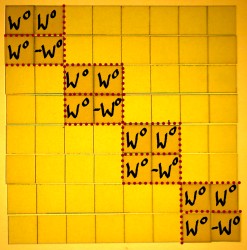
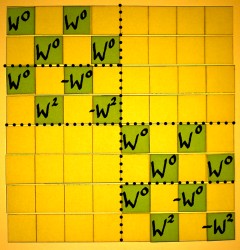


Now that I learned how a Fourier matrix can be decomposed into
radix 2 FFT factors, the next challenge is to implement this in a
computer language. After all, outside a computer even the optimallest
Fast Fourier Transform is of little practical use. Although the first
invention of the technique dates from the early nineteenth century...
Below is the sketch of a radix 2 FFT for N=8, as it was figured out
on preceding pages, and from which I will depart:
 |
 |
 |
 |
A routine for this FFT could or should be organised as a series of
nested
loops. I have seen this principle outlined in texts on FFT, notably in
The Fast Fourier Transform by E. Oran Brigham, Numerical Recipes
in C by William H. Press e.a., and Kevin
'fftguru' McGee's online FFT tutorial. The point is that I had a
hard time to understand the mechanics of it. So I went step by step,
studying texts and code, and working out my coloured square paper
models in parallel. FFT was like a jig saw puzzle for me, and this page
reflects how I was putting the pieces together.
In the matrix representation, the structure of an FFT shows several
layers:
- the sparse factor matrices representing the FFT stages
- submatrices appearing in each factor matrix
- row entries appearing pairwise in each submatrix
An FFT implementation can be organised accordingly, and for the
moment I will just sketch that roughly:
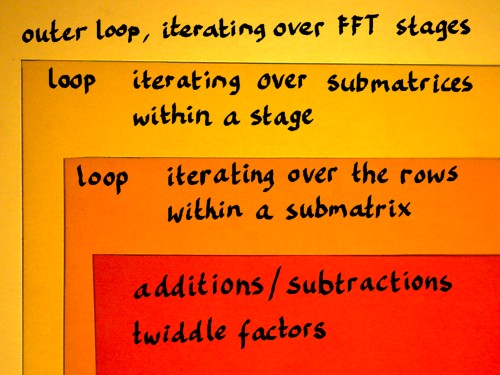 |
When we look at the FFT factor matrices, there is a kind of virtual
vector size that is smaller and smaller in each consecutive stage. In
the first stage, this size is N/2 and in the last stage it is reduced
to just 1.
I feel that we should inspect the indexes in their binary form for a
moment. Binary integer numbers are what computers use internally
for indexing, which in turn is an incentive to do radix 2 FFT. If there
is a pattern to perceive, it is best
perceived in the binary numbers. Here is the addition/subtraction
matrix of the first stage, with all indexes written in binary:
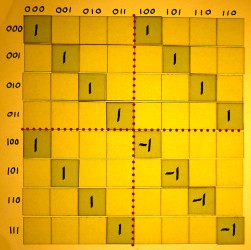 |
 |
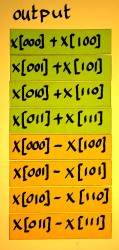 |
N/2 can also be defined N>>1, which means N
shifted right by one bit: 1000 becomes 0100. It is a pure power of two
everytime. Instead of using 4 as a
constant, or writing N/2 a couple of times, it would be efficient to
store the value in some variable, and update it in every stage. I will
label this variable 'span', as that seems an appropriate title for this
essential parameter.
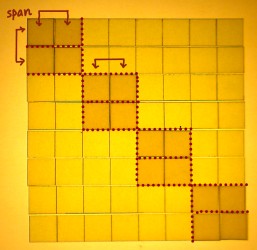 |
 |
 |
We can declare span as a variable of
datatype unsigned int, and initialize it at the start of the outer
loop:
span = N>>1;
Span can be decremented in appropriate steps for the iterations over
the FFT stages:
span >>= 1;
From 0100 it will shift to 0010 in the second stage and to 0001 in
the
third stage. After that it will shift right from 0001 to 0000, which is
also boolean 'false'. That
is where the outer loop should end indeed. Therefore the variable span
can also regulate the conditions for the outer loop.
Let me insert this into the rough FFT sketch, in C manner:
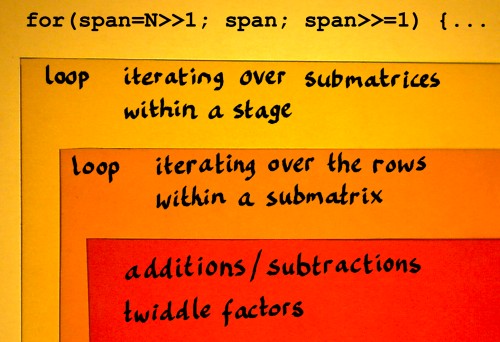 |
Index numbers can now be referenced as x[n] and x[n+span]. That is
how we can identify sample pairs for addition/subtraction. This
identification method will only run smooth when the work will be done
on one submatrix at a time, within each stage. Otherwise x[n] will
overlap with x[n+span]. We could write a for-loop that iterates over
the submatrices in a stage.
 |
Every stage has it's own amount of submatrices. The first stage has
just one NxN matrix. The second stage shows two submatrices.
The third stage has four submatrices. The amount of
submatrices in each stage is inversely proportional to span. More
precisely, it is N/(span*2) or (N>>1)/span. Our for-loop can be
something
like:
|
start with submatrix=0;
|
Adding these considerations to the FFT plan:
 |
Within each submatrix we have to perform addition/subtraction and compute output pairs of the following kind:
|
x[n]+x[n+span];
|
I have seen such pairs being called 'dual node pairs', in Oran
Brigham's book 'the Fast Fourier Transform'. There, the term applies to
points where things come together in a butterfly figure. There is no
butterflies here, but I like the term. Let me identify such a dual node
pair like it shall be computed in the first FFT stage:
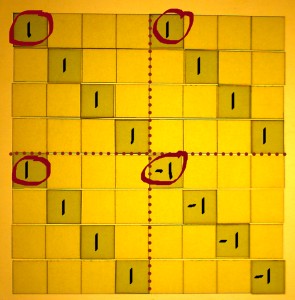 |
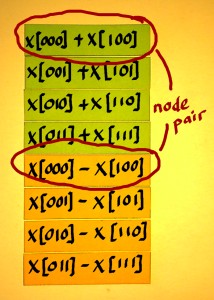
|
|
How many dual node pairs do we have in a submatrix? There is already
a
variable that has the correct value: span. We can iterate over the dual
node pairs using a straightforward loop that I will add to my
preliminary scheme:
 |
After finishing the iterations over the nodes, n has to jump over
the x[n+span] values. But it must not get bigger than N. It can be done
like: n=(n+span)&(N-1). The &(N-1) is a bitwise-and mask, for
example: binary 11111 is such a mask in the N=32 case.
Until here I have three for-loops written down, but all the work of
calculating the content still has to be done. What a crazy routine it
is... Let me then see how to handle the additions/subtractions of
the dual node pairs:
|
x[n]=x[n]+x[n+span];
|
Aha. Here is a small problem: in this way the original value of
x[n] can not be used for the computation of x[n+span], as it is already
overwritten in the first line. Unfortunately, a temporary
variable is needed to store the new value for x[n] for a short while:
|
temp=x[n]+x[n+span]; |
This is all still quite theoretical, because x[n] is a complex
variable in real life. Let us split x[n] in real[n] and im[n] for the
moment, and check how the code could expand:
|
temp=real[n]+real[n+span]; |
Now it turns out that for each n, the value [n+span] is already
computed six times. Shall I not store this value before the additions
and subtractions, in a variable called nspan? (Yep).
What comes next? We need to multiply the x[nspan] output values
with twiddle factors. This is best done while these output values are
still at hand, in the CPU registers (hopefully) or else somewhere
nearby in cache. The twiddling is therefore inside the loop over the
nodes, the innerest loop. Directly after the subtraction
x[nspan]=x[n]-x[nspan], x[nspan] can be updated with the
twiddle factor. Again, this is somewhat more complicated in real life,
as it concerns a complex multiplication. And furthermore, we do not
have these twiddle factors computed yet. So here I really have to
start a new topic.
Twiddling
The twiddle factors shall be square roots of unity and square roots
thereof, etcetera, related to each stage. Our N=8 FFT starts with the
eight-roots of unity. The angle in radians for the primitive eight-root
of unity, the first interval, could be computed with -2pi/8. But we
have this handy variable span, initialized at N/2 and updated for each
FFT stage. Therefore, angle of the primitive root for each stage can be
computed
as: -pi/span. So span functions as a complex root extractor, cool...
This
primitive root angle has to be updated for each new iteration within
the
outer loop:
|
primitive_root = MINPI/span; // define MINPI
in the header |
If this root angle is multiplied with the node variable in the
innerest
loop, we have the correct angle for every twiddle factor:
|
angle = primitive_root * node;
|
From this angle, sine and cosine must be computed. That could simply
be done like:
|
realtwiddle = cos(angle); |
I will postpone my comments on this till later, let me first try to
finish the routine. real[nspan] and im[nspan] need complex
multiplication with realtwiddle and imtwiddle. Again, a temporary
variable is inevitable:
|
temp = realtwiddle * real[nspan] - imtwiddle * im[nspan]; |
For the next node, n must be incremented. We're done! Let me now put
these
codebits together.
|
} // end of FFT function |
With some twenty lines of C code we can have an FFT
function. The output of this FFT appears in bit-reversed order, so for
analysis purposes it does not make much sense yet. I will figure out
bitreversal on a separate page. Furthermore, the
output is not normalised in any way.
Of course, this simple FFT code is still highly inefficient. The
real killer is: the calling of standard trigonometrics, cos() and
sin(). Why is that so? For one thing, the hardware FPU trig
instructions generate 80 bits precision output by default. They really
take a lot of clock cycles. If we are to optimize the code, here is the
obvious point to start. The next page shows some modifications.